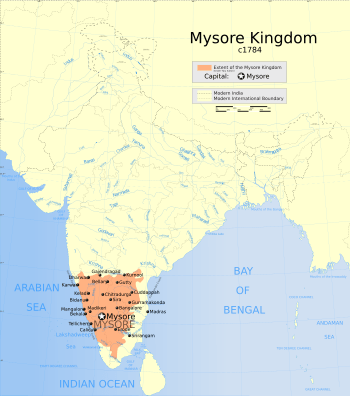Kingdom of Mysore facts for kids
Quick facts for kids
Kingdom of Mysore
Princely State of Mysore |
|||||||||
|---|---|---|---|---|---|---|---|---|---|
| 1399–1950 | |||||||||
|
Anthem: Kayou Sri Gowri
|
|||||||||

Kingdom of Mysore, 1784 AD (at its greatest extent)
|
|||||||||
| Status | Kingdom (Subordinate to Vijayanagara Empire until 1565). Princely state under the suzerainty of the British Crown after 1799 |
||||||||
| Capital | Mysore, Srirangapatna | ||||||||
| Common languages | Kannada | ||||||||
| Religion | Hinduism, Islam | ||||||||
| Government | Monarchy until 1799, Principality thereafter | ||||||||
| Maharaja | |||||||||
|
• 1399–1423 (first)
|
Yaduraya | ||||||||
|
• 1940–50 (last)
|
Jaya Chamaraja Wodeyar | ||||||||
| History | |||||||||
|
• Established
|
1399 | ||||||||
|
• Earliest records
|
1551 | ||||||||
|
• Disestablished
|
1950 | ||||||||
|
|||||||||
| Today part of | India | ||||||||
The Kingdom of Mysore was an important kingdom in southern India. It is believed to have started in 1399 near the city of Mysore. The kingdom was ruled by the Wodeyar family.
At first, Mysore was a smaller state that served the powerful Vijayanagara Empire. But when the Vijayanagara Empire became weaker around 1565, the Kingdom of Mysore became independent.
In the 17th century, Mysore grew much larger. Under rulers like Narasaraja Wodeyar I and Chikka Devaraja Wodeyar, the kingdom took over large areas. These areas are now parts of southern Karnataka and Tamil Nadu. Mysore became a strong state in the southern Deccan.
Contents
Mysore's Golden Age and Wars
The Kingdom of Mysore was strongest in the late 1700s. This was when Hyder Ali and his son Tipu Sultan were in charge. They were not the official kings, but they held the real power.
Conflicts with Other Powers
During this time, Mysore often fought with other powerful groups. These included the Marathas, the Nizam of Hyderabad, and the Kingdom of Travancore. Mysore also fought against the British. These conflicts led to four major wars, known as the Anglo-Mysore Wars.
Mysore won the first war against the British. The second war ended in a tie. But Mysore lost the third and fourth wars. After Tipu Sultan died in the fourth war in 1799, the British took over large parts of his kingdom.
Mysore as a Princely State
The British then put the Wodeyar family back on the throne. However, Mysore became a "princely state." This meant it was still ruled by its own king, but it was under the control of the British. The Wodeyars continued to rule until India became independent in 1947. After that, Mysore joined the Union of India.
Mysore's Advanced Rockets
Mysore was known for its advanced military technology. Tipu Sultan and his father Hyder Ali developed the first iron-cased rockets in the 1780s. These rockets used iron tubes to hold the fuel. This made them more powerful and able to fly farther, up to 2 kilometers (about 1.2 miles).
Influence on British Rockets
The Mysore rockets were much more advanced than anything the British had seen. After Tipu Sultan's defeat in the Fourth Anglo-Mysore War, the British captured these rockets. They studied them, and this inspired the development of the Congreve rocket. These British rockets were later used in the Napoleonic Wars.
Culture and Economy
Even as a princely state, Mysore was one of the most developed and modern regions in India. Between 1799 and 1947, Mysore also became a major center for art and culture.
Patronage of Arts
The kings of Mysore loved and supported the fine arts. They were also skilled artists and writers themselves. Their support for music and art still influences these fields today.
Farming and Land Tax
Most people in the Kingdom of Mysore lived in villages. Their main job was farming. They grew grains, pulses (like lentils), vegetables, and flowers. They also grew commercial crops like sugarcane and cotton.
Landlords owned most of the farmland. They hired landless workers to help them grow crops. These workers were usually paid in grain. Smaller farmers would also work as laborers if they needed to.
Because there was a lot of land and not many people, landowners did not pay rent. Instead, they paid a tax on their crops. This tax could be up to half of everything they harvested.
Changes Under British Rule
This system changed when the British took control. Taxes had to be paid in cash. This money was used to pay for the army, police, and other government services. Some of the tax money was also sent to England as a "tribute" from India.
Many farmers were unhappy with these changes. They lost their traditional way of paying taxes and faced new problems. This led to rebellions in many parts of southern India. After 1800, new land reforms were put in place by the British.
Images for kids
-
Admiral Suffren meeting with ally Hyder Ali in 1783. J. B. Morret engraving, 1789
-
The flag of the Sultanate of Mysore at the entrance to the fort of Bangalore
-
A portrait of Tipu Sultan, made during the Third Anglo-Mysore War
-
Mural of the famous Battle of Pollilur in Tipu Sultan's summer palace in Srirangapatna
-
Lord Cornwallis hastily retreats after his unsuccessful siege of Srirangapatna (1792).
-
The Gopura (tower) of the Chamundeshwari Temple on the Chamundi Hills. The temple is dedicated to Mysore's patron deity.
-
The Jaganmohan Palace at Mysore – now an art gallery which is home to some of Raja Ravi Varma's masterpieces
-
Tipu Sultan's tomb at Srirangapatna
-
Lalitha Mahal at Mysore, now a five-star hotel, plays host to visiting dignitaries and VIPs.
See also
 In Spanish: Reino de Mysore para niños
In Spanish: Reino de Mysore para niños
























